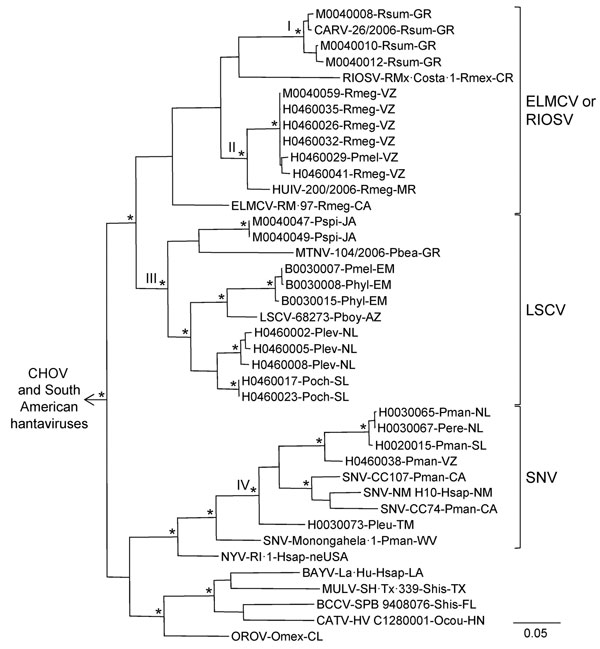Volume 18, Number 4—April 2012
Research
Geographic Distribution of Hantaviruses Associated with Neotomine and Sigmodontine Rodents, Mexico
Figure 2

Figure 2. Results of the Bayesian analyses of the nucleotide sequences of a fragment of the nucleocapsid protein genes of the 24 hantaviruses found in Mexico in this study and 22 other hantaviruses naturally associated with members of the Neotominae or Sigmodontinae. An asterisk at a node indicates that the probability values in support of the clade were >0.95. Scale bar indicates substitutions per site. The Roman numerals indicate the phylogenetic groups represented by the hantaviruses from Mexico in this study. The branch labels include (in the following order) virus, strain, host species, and state or country. BAYV, Bayou virus, strain LA-Hu (GenBank accession no. L36929); BCCV, Black Creek Canal virus, SPB 9408076 (L39949); CARV, Carrizal virus, 26/2006 (AB620103); CATV, Catacamas virus, HV C1280001 (DQ256126); CHOV, Choclo virus, 588 (DQ285046); ELMCV, El Moro Canyon virus, RM-97 (U11427); HUIV, Huitzilac virus, 200/2006 (AB620106); LSCV, Limestone Canyon virus, 68273 (AF307322); MTNV, Montano virus, 104/2006 (AB620100); MULV, Muleshoe virus, SH-Tx-339 (U54575); NYV, New York virus, RI-1 (U09488); OROV, Playa de Oro virus (EF534079); RIOSV, Rio Segundo virus, RMx-Costa-1 (U18100); and SNV, Sin Nombre virus strains Convict Creek 74 (CC74), Convict Creek 107 (CC107), Monongahela-1, and NM H10 (L33816, L33683, U32591, and L25784, respectively). The viruses found in South America were Andes virus, strain Chile-9717869 (GenBank accession no. AF291702); Caño Delgadito virus, VHV-574 (DQ285566); Laguna Negra virus, 510B (AF005727); Maporal virus, HV 97021050 (AY267347); and Rio Mamoré virus, HTN-007 (FJ532244). Locations: AZ, Arizona; CA, California; CL, Colima; CR, Costa Rica; EM, México (state); FL, Florida; GR, Guerrero; HN, Honduras; JA, Jalisco; LA, Louisiana; MR, Morelos; NL, Nuevo León; NM, New Mexico; neUSA, northeastern United States (New York or Rhode Island); SL, San Luis Potosí; TM, Tamaulipas; TX, Texas; VZ, Veracruz; WV, West Virginia. Species: Hsap, Homo sapiens; Pbea, Peromyscus beatae; Pboy, P. boylii; Pere, P. eremicus; Phyl, P. hylocetes; Pleu, P. leucopus; Plev, P. levipes; Pman, P. maniculatus; Pmel, P. melanotis; Poch, P. ochraventer; Pspi, P. spicilegus; Ocou, Oryzomys couesi; Omex, O. mexicanus; Rmeg, Reithrodontomys megalotis; Rmex, R. mexicanus; Rsum, R. sumichrasti; Shis, Sigmodon hispidus. The designated outgroup was Andes virus strain Chile-9717869.
1These authors contributed equally to this article.